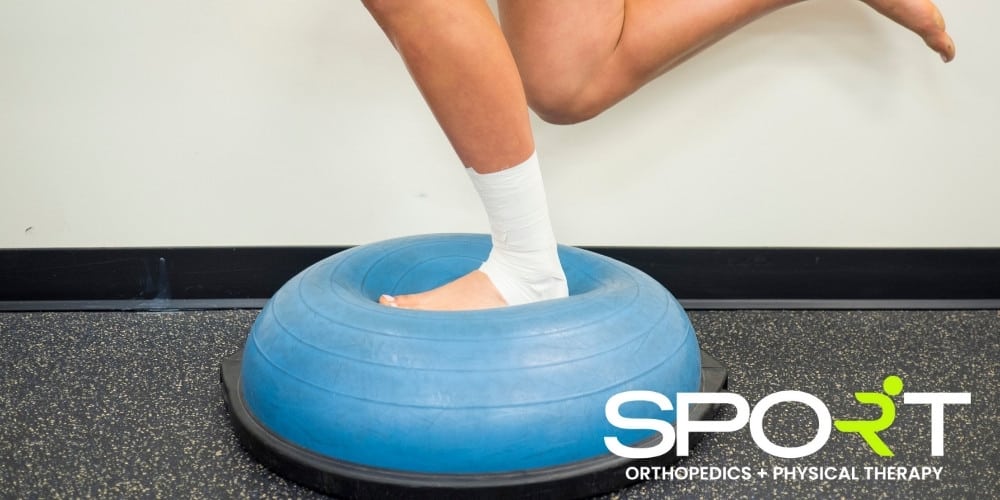
Countless athletes and hobbyists suffer from ankle sprains and strains each year. While foot and ankle pain are very common in athletes due to the nature of their everyday activities, anyone can suffer from an ankle injury. Even just stepping awkwardly or tripping on an uneven sidewalk can result in ankle joint pain. Luckily, with the help of a trained physical therapist and a few ankle strengthening exercises, you can strengthen your weak ankles in no time.
When your ankle strength is low, and your range of motion is poor, you could experience chronic ankle instability. However, SPORT Orthopedics + Physical Therapy offers a personalized ankle conditioning program for those looking to strengthen their weak ankles. If you have a previous ankle injury, or if you’re looking to prevent further injury to your ankle, we’re here for you. Our Dallas physical therapists will evaluate each ankle joint carefully, then develop a plan that works for you. To schedule an appointment with us, please call 469-200-2832 today. You can also schedule your appointment online.

Having even one weak or tight joint can greatly affect your daily life. This is especially true when that weak joint is located in your legs or ankles. Our legs and ankles carry us through life. So, when those are weak, we become more prone to certain strains, sprains, and other injuries. Below, we outline a few ways in which weak or tight ankles can impact your life.

Now you may be thinking, “How strong are my ankles?” Luckily, there are two ways to test the strength, balance, and mobility of your foot and ankle. The first test will measure your balance and strength.
First, stand near a stable object, such as a wall or railing. This will prevent you from falling if you lose your balance. Plant one foot firmly on the ground, then raise your other foot a few inches off the ground with your knee slightly bent. Keep track of how long you can keep your balance on one foot without reaching for the wall or putting your other foot on the ground. Try this both with your eyes closed and open. The longer you can hold this position, the higher your level of strength and balance.
The second test will measure your mobility. You will need a short strip of tape and a tape measure. Place the strip of tape 4 inches away from the wall, parallel to the wall. Place the toes of your left foot on the tape, pointing toward the wall. Situate the right foot slightly behind you and lean against the wall with your palms. Slowly bend your left knee toward the wall until it touches the wall. If you cannot touch the wall, slowly scoot your left toes forward until your knee touches the wall. Measure the distance between your toes and the wall. The greater the distance, the greater your mobility. Repeat these steps with the opposite foot.
Whether you’re an athlete or otherwise, it’s important to strengthen your joints and practice mobility exercises on a regular basis. Maybe you’re seeking to strengthen your ankles after an injury, or maybe you’re prone to strains and sprains. Either way, working to strengthen any part of your body is an admirable goal.
There are many ways to begin strengthening your ankles. At SPORT, we recommend seeking professional medical advice from our licensed physical therapists. Our physical health and wellness professionals have extensive experience helping injured patients slowly return to their regular activities. Exercise, stretching, strength training, and mobility exercises are just a few of the ways in which we work to strengthen your ankles and avoid future injuries.
Read on to explore the various types of exercise we may recommend in your personalized treatment plan.
With the exercises we list below, you can strengthen not only your ankles but also your calf muscles and the ligaments in your ankle. In other words, many of the exercises that we recommend for our patients often target multiple areas of the lower legs. This ensures that there are no weak points in your legs that could lead to injuries.

Regular walks are a great, low-impact way to improve your legs and ankles. However, pairing a low-impact exercise with strength and mobility exercises is ideal for preventing injuries. In the next section, we review our personal favorite exercises for ankle strengthening.
Below, our SPORT Orthopedics + Physical Therapy team experts outline some of the most effective ankle strengthening exercises.

Weight-bearing exercises are particularly effective for building strength.
Using a resistance band is a great way to slowly and easily build your strength. Begin by sitting on the floor with your legs stretched straight in front of you. Wrap the resistance band around the ball of your left foot. Your starting position should be with your toes pointed upward. Point your toes away from you, as if you’re pressing a gas pedal in a car. Then pull your toes back toward you. Repeat these motions 20 times, then repeat the process with your other leg.
Below, we list other effective ankle strengthening exercises while using resistance bands.
Non-weight-bearing exercises are effective for mobility, balance, and flexibility.
One of the most effective exercises for the ankles is called the “ankle alphabet.” It helps people achieve a greater level of mobility in all possible directions that the ankle can move in. Start by sitting in a chair. Pretend that your big toe is the tip of a pen, then “write” each letter of the alphabet. Do this first with one leg, then with the other.
Below, we list other exercises that are low-impact and non-weight-bearing. Beginning with non-weight-bearing exercises is essential to restoring functionality to your affected leg if you have suffered an injury. Each exercise will involve your body weight rather than more weight.

Ankle strengthening exercises have multiple benefits for both recoveries after an injury and for preventing injuries. We list some of these benefits below.

At SPORT Orthopedics + Physical Therapy, our goal is to not only treat your injuries but also to give you the tools necessary to prevent injuries in the future. Once we identify and treat the source of your pain, we will provide an educational service geared towards teaching you about proper posture, proper form, and injury prevention. Especially for athletes, this is crucial. If you sustained an ankle injury and you’re having trouble getting back in the game, contact SPORT today and schedule an appointment with us. You can call our Dallas or Frisco office at 469-200-2832, or schedule your appointment online.








*We accept most all insurance plans, if you do not see your plan listed above or have any questions, please contact our office.

SPORT Orthopedics + Physical
Therapy – Dallas, TX
Services:
• Clinic • Orthopedic • Urgent Care
• Physical Therapy
18152 Preston Road
Suite I-2
Dallas, TX 75252
Phone: (469) 200-2832
Fax: (469) 269-1074
SPORT Orthopedics + Physical Therapy – Frisco, TX
Services:
• Clinic • Orthopedic • Urgent Care
• Physical Therapy
9255 Dallas Parkway
Suite I20
Frisco, TX 75033
Phone: (469) 200-2832
Fax: (469) 269-1074
SPORT Orthopedics + Physical
Therapy – Wylie, TX
Services:
• Clinic • Orthopedic • Urgent Care
• Physical Therapy
3400 FM 544
Suite 650
Wylie, TX 75098
Phone: (469) 200-2832
Fax: (469) 269-1074
SPORT Physical
Therapy – Prosper, TX
Services:
• Physical Therapy
790 N Preston Rd
Suite 60
Prosper, TX 75078
Phone: (469) 850-0201
Fax: (469) 269-1074
SPORT Orthopedics – Mesquite, TX
Services:
• Clinic
• Orthopedic
• Urgent Care
1102 North Galloway Ave
Mesquite, TX 75149
Phone: (469) 200-2832
Fax: (469) 269-1074